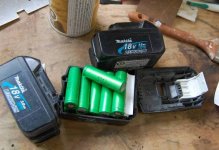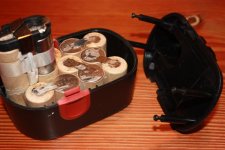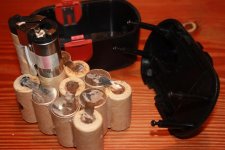Please more specific....are you talking about those portable, rechargable 7.2, 18.0 etc. volt type drills??
If so...I had one that wouldn't hold a charge...so I just left off the 'battery pack & put some spade connectors on a piece of zip-cord with some polarized alligators.& away you go. Tapping off a car battery (Car work) or a SLA battery(7.2AH) I have kicking around (Makes a great lantern with a "foglight") My drill in question was a 7.2 V version & it loves 12V (Or less).
___________________________________________________Rick....
If so...I had one that wouldn't hold a charge...so I just left off the 'battery pack & put some spade connectors on a piece of zip-cord with some polarized alligators.& away you go. Tapping off a car battery (Car work) or a SLA battery(7.2AH) I have kicking around (Makes a great lantern with a "foglight") My drill in question was a 7.2 V version & it loves 12V (Or less).
___________________________________________________Rick....
Tinitus, why not rebuild the pack yourself? They usually contain standard size ni-cad cells that can be bought individually.
I will be rebuilding some laptop batteries on Monday. I managed to snag some 11.1V li-ion battery packs (for a different model laptop) on ebay for $1.99 each. They each contain 6x 18650 cells that would cost me about $3.25 each if I bought them separately.
I will be rebuilding some laptop batteries on Monday. I managed to snag some 11.1V li-ion battery packs (for a different model laptop) on ebay for $1.99 each. They each contain 6x 18650 cells that would cost me about $3.25 each if I bought them separately.
Tinitus, why not rebuild the pack yourself? They usually contain standard size ni-cad cells that can be bought individually.
Richard, yes, the portable ones
Anonymous
Thats exactly what was on my mind, right after posting
So, the battery casing is just an "empty shell", with a "standard" battery inside
Thats interesting
Just to give it some perspective
Around her, replacing a good hand tool battery could cost maybe 100-150USD
Anyone ever tried to make a power supply to replace a worn battery
I have been meaning to do just that.
I have an 18V DeWalt that I don't have any good batteries for anymore that I want to use.
Supply: You need some good current from the supply to equal the ooomph of a battery - I have the transformer from a car battery charger. Rectify that with a FWB and 10000uF cap for smoothing should be A-OK.
There are some real upsides to this. First, obviously no charging the battery. Second is it is pretty much fixed in one place, as in hard to take somewhere else and forget about. It'll be where I often need to use such a tool and always be right there.
So, the battery casing is just an "empty shell", with a "standard" battery inside
The cells are usually of a different size than standard and they are connected together with strips of metal that are spot welded on. It's a big deal to re-cell a battery pack for a drill and you'll want to make absolutely sure the cells are in excellent shape. One bad cell kills the battery.
Lithium ion batteries have a relatively short lifespan and will conk regardless of whether they have been used or not. Keeping them cool will greatly increase their lifespan.
I've taken apart a few different packs - DeWalt NiCad has cells that are close in size to C-cells. Makita LiIon look like AA but are much longer and thicker:

Yes of course the 'casing' is an empty shell...Didn't know? Oh well.
The "batteries" are standard size type, D,C, AA.
The batteries usually have the polarities soldered with a small metal tab, in a pack, sometimes taped up. You can tell as the dimensions & voltages give it away as to what size batteries are contained inside.
The reverse is possible too....I had a 'portable' phone that was dead but the batteries in the handset were OK....three AA, NiCads'.
Did you know a 9V battery has a set of Quad As' inside???I have a "Streamlight" skinny LED pencil-lamp, takes AAAA inside...a single nine volt will get you replacements as AAAAs' are rare as hensteeth.
________________________________________________________Rick....
The "batteries" are standard size type, D,C, AA.
The batteries usually have the polarities soldered with a small metal tab, in a pack, sometimes taped up. You can tell as the dimensions & voltages give it away as to what size batteries are contained inside.
The reverse is possible too....I had a 'portable' phone that was dead but the batteries in the handset were OK....three AA, NiCads'.
Did you know a 9V battery has a set of Quad As' inside???I have a "Streamlight" skinny LED pencil-lamp, takes AAAA inside...a single nine volt will get you replacements as AAAAs' are rare as hensteeth.
________________________________________________________Rick....
I was too cheap to buy a new battery for the yard sale Makita drill, but I wanted a driver drill for screwing together speaker cabinets. So... I found a scrap of MDF that was roughly the size of a battery pack, split some zip cord and taped it to the MDF with the bared ends spread out where the battery terminals would be. Later, I took the terminals from an old battery, soldered zip cord to them, and glued them up into an old battery shell. That was more reliable than the MDF and tape arrangement.
I've generally used a 12V gel cell to run it, or the battery of my truck. The two extra volts doesn't seem to hurt the 9.6V drill any.
I've never measured the current, but I suspect it would take an inconveniently large linear supply to do any useful work. A PC supply looks ideal, since they can often supply over 10 amps at 12V, don't weigh much, and cost nothing if rescued from an obsolete computer.
I've generally used a 12V gel cell to run it, or the battery of my truck. The two extra volts doesn't seem to hurt the 9.6V drill any.
I've never measured the current, but I suspect it would take an inconveniently large linear supply to do any useful work. A PC supply looks ideal, since they can often supply over 10 amps at 12V, don't weigh much, and cost nothing if rescued from an obsolete computer.
Last edited:
I once had an "affordable" Ryobi 18V circular saw. The battery supplied didn't live long enough to put any wear at all on the tool. Then I had an application that called for running a circular saw inverted, and the "real" corded one I have was much too big and heavy. After looking up the specs on the Mabuchi motor in the cordless saw, I found that it was rated for 24V, 50A. 100A stalled rotor.
I put 2 7.2AH AGM lead acid batteries seriesed in a fanny pack and ran wires into the gutted NiCd pack and sawed away. I thought about fusing but went to work without the parts on hand.
The saw ran Very well.
YMMV
I put 2 7.2AH AGM lead acid batteries seriesed in a fanny pack and ran wires into the gutted NiCd pack and sawed away. I thought about fusing but went to work without the parts on hand.
The saw ran Very well.
YMMV
Last edited:
for a workbench stationary, sure, I would just use a 12V lead acid too
man, this machine has served me well for maybe 15 years and it was used when I got it
and it was used when I got it
shame to throw it away now

I am looking for a new one with 2 or 3 batteries
I have learned my lesson with cheap ones
good batteries is what matters, and exstra ones for longer life
but nice have one or two exstra machines, for lighter job parts
its a pain to constantly change 2 or 3 drills and bits every minute
thats why I would like this one to work, just a little
man, this machine has served me well for maybe 15 years
shame to throw it away now

I am looking for a new one with 2 or 3 batteries
I have learned my lesson with cheap ones
good batteries is what matters, and exstra ones for longer life
but nice have one or two exstra machines, for lighter job parts
its a pain to constantly change 2 or 3 drills and bits every minute
thats why I would like this one to work, just a little
I have been using my (used to be) cordless drill that way for more than 8 years now. it's a really old craftsman 6V. I shortened the handle by about 2" and added wires. rewound it for 12V and can be powered by alligator clips to a car battery or my 11.1V Li Poly battery pack I use for airsoft.
you can see a picture of it in here: Car subwoofer box
you can see a picture of it in here: Car subwoofer box
- Status
- This old topic is closed. If you want to reopen this topic, contact a moderator using the "Report Post" button.
- Home
- Design & Build
- Equipment & Tools
- Drill machine, replacing battery with stationary supply

